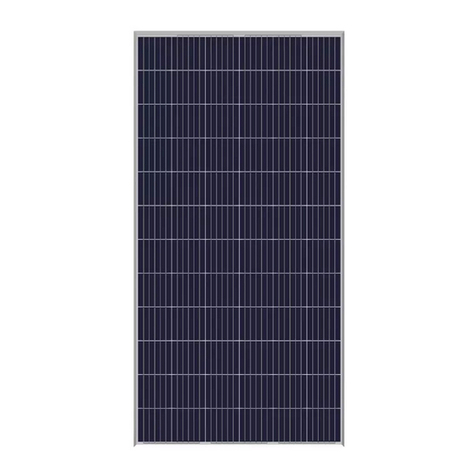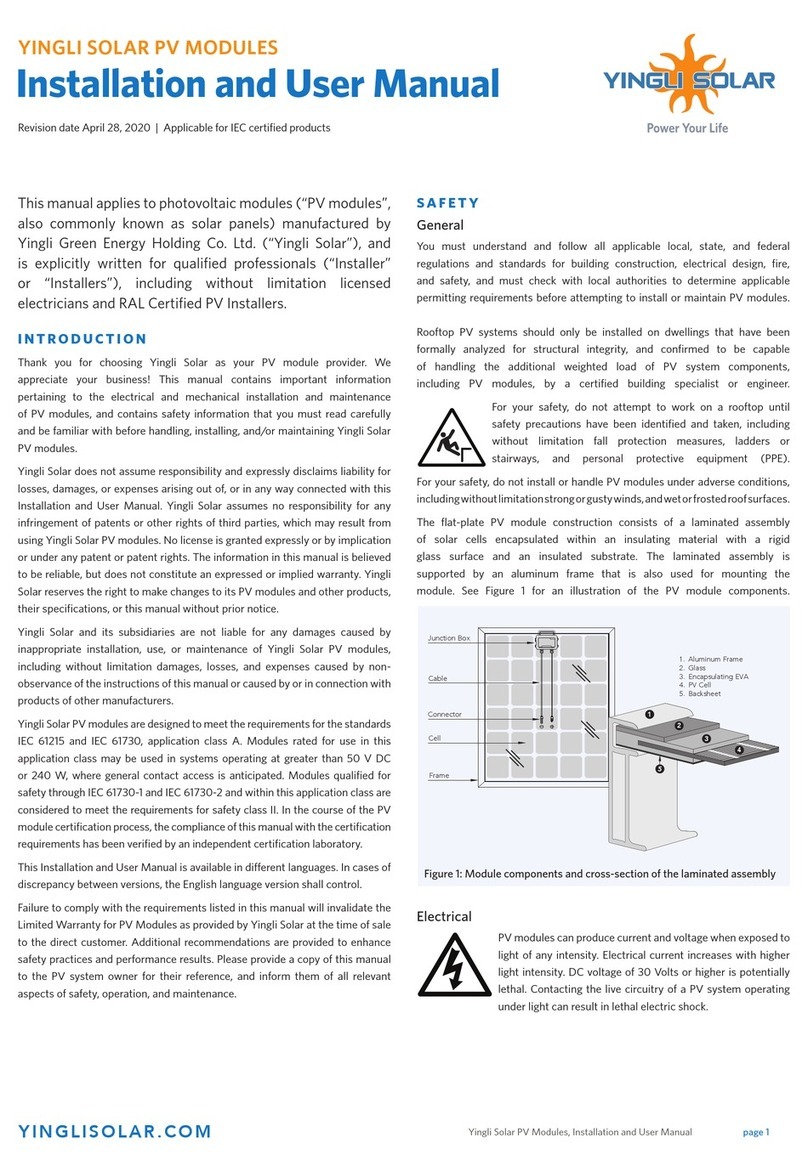
Yingli Solar G/G Modules, Installation and User Manual page 2
modify them in any way in order to secure an electrical connection.
Do not touch or handle PV modules with broken glass or separated frames,
unless the modules are disconnected and you are wearing proper personal
protective equipment. Avoid handling PV modules when they are wet unless
cleaning the PV modules as directed in this manual. Never touch electrical
connections that are wet without protecting yourself with insulated gloves.
Transport and Handling
Yingli Solar PV modules must be transported in the supplied packaging only,
and kept in the packaging until they are ready to be installed. At time of receipt,
please verify that the delivered product is in fact the product ordered. The
product name, subname and serial number of each laminate are clearly marked
on the outside of each packing box.
Protect pallets against movement and exposure to damage during transportation.
Do not exceed the maximum allowable height of pallets to be stacked, as
indicated on the pallet packaging. Secure pallets from falling over. If pallets are
stored temporarily outside please place a protective covering over the pallet to
protect it from direct weathering and do not stack pallets.
Figure 2: Pallet of PV modules
At the installation site, take care to keep modules and their electrical contacts
clean and dry before installation. If connector cables are left in damp conditions
then the contacts may corrode. Any module with corroded contacts should not
be used. Yingli Solar PV modules are heavy, and should be handled with care,
so non-slip gloves are required when handling and installation. Please never
use the junction box or cables as a grip. Do not exert mechanical stress on the
cables. Never steps on PV modules or drop or place heavy objects on them.
Be careful when placing PV modules on hard surfaces, and secure them from
falling. Broken glass can result in personal injury. PV modules with broken glass
cannot be repaired and must not be used. Broken or damaged PV modules must
be handled carefully and disposed of properly.
For unpacking frameless PV modules from supplied packaging, firstly, remove
the pallet lid after removing security straps, and then remove the carton, paper
corner and foam rubber. Remove PV modules one at a time by sliding them up
the channel in the package with both hands (see Figure 3). You may need to
secure the remaining PV modules in the pallet packaging to prevent them from
falling over.
Figure 3: Packaging structure of frameless PV modules
For unpacking framed PV modules ensure that the pallet stands firm and that it
isn´t inclined in such a way that modules can slide out during
the unpacking process (opening side shouldn´t face downwards). Cut the two
longitudinal and the two inner transverse security straps. Carefully cut and
remove the cardboard of one short side of the box including the corresponding
part of the upper lid and the bottom lid (see Figure 4). Pay attention to not
damage the modules during the cutting process. Thirdly cut the two inner
security straps around the modules, remove the two paper corners and pull
slowly out the modules one by one. You may need to secure the remaining PV
modules in the pallet packaging to prevent them from falling over.
Figure 4: Cutting cardboard and pull out modules
Check PV modules for damage due to transportation before installation. Do not
install damaged modules. Please contact the company you have purchased the
Yingli Solar PV modules for information or complaints.
PV module surfaces are susceptible to damage that could aect the performance
or safety of the module. Do not damage or scratch the PV module surfaces, and
do not apply paint or adhesive to any of the surfaces, including the frame. For
your safety, do not disassemble or modify the modules in any way. Doing so may
degrade performance or cause irreparable damage and will void any applicable
warranties.
If it is necessary to store PV modules prior to installation, the PV modules
should remain inside the packaging and protected from exposure that could
compromise the durability of the packaging.
Fire
Yingli Solar PV modules have a class A fire resistance rating in accordance with
the IEC 61730-2 certification, while the materials of modules for class A please
refer to the test report and CDF document. When PV modules are mounted
on the rooftops, the roof must have a fire resistant covering suitable for this
application. PV modules are electrical generating devices that may aect the
fire safety of a building.
The use of improper installation methods and/or defective parts may result
in the unexpected occurrence of an electrical arc during operation. In order to
mitigate the risk of fire in this event, PV modules should not be installed near
flammable liquids, gases or locations with hazardous materials.
In the event of a fire, PV modules may continue to produce a dangerous
voltage, even if they have been disconnected from the inverter, partly or entirely
destroyed, or the system wiring has been compromised or destroyed. In the
event of fire, inform the fire crew about the particular hazards from the PV
system, and stay away from all elements of the PV system during and after a fire
until the necessary steps have been taken to make the PV system safe.
APPLICATION INFORMATION
Application Restrictions
Yingli Solar PV modules must be mounted on appropriate structures, positioned
on buildings, the ground, or other places suitable for PV modules (e.g. carports,
building facades or PV trackers). PV modules must not be mounted on moving
vehicles of any kind. Yingli Solar PV modules must not be installed in locations
where they could be submerged in water.
Yingli Solar PV modules must not be sited in locations where aggressive
substances, such as salt or salt-water, or any other type of corrosive agent, could
aect the safety and/or performance of the PV modules.
































